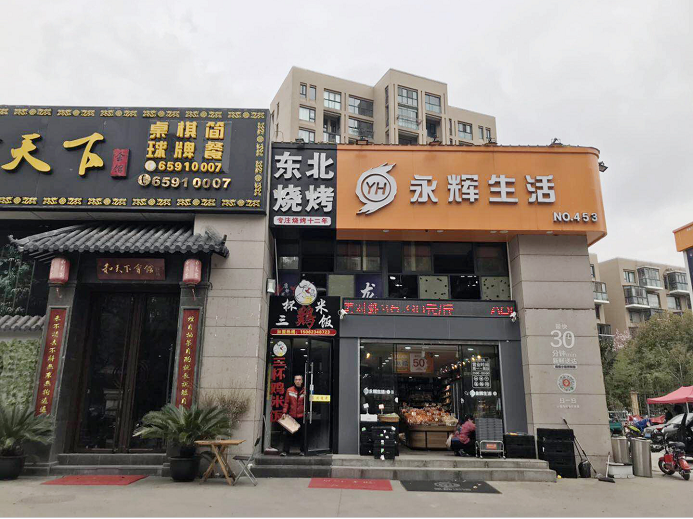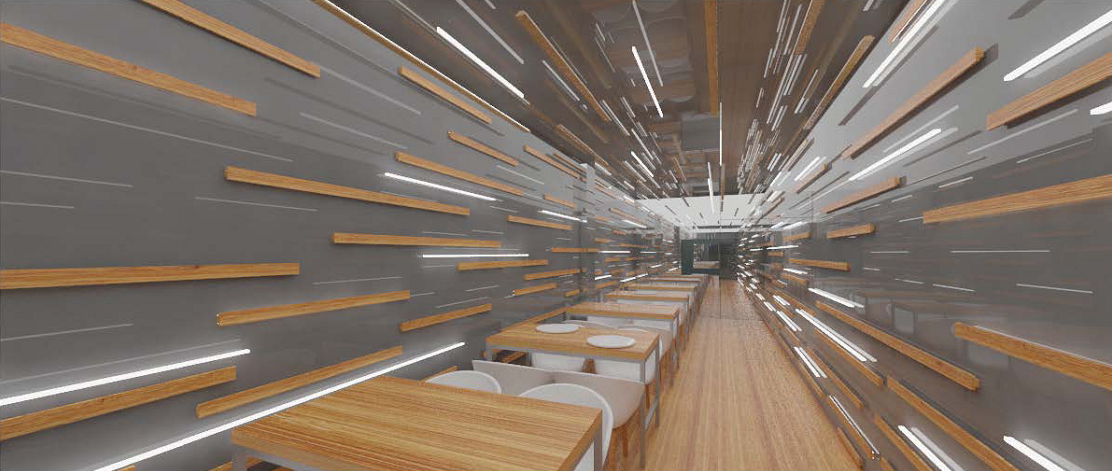夹缝里的捞饭店
项目位于江苏省苏州市工业园区九华路,处于周边多个住宅区的生活中心。原店是三杯鸡米饭/东北烧烤,是小区临街的一间商铺,空间单一且狭小。店面的立面非常狭长,内部空间相应也是极其狭长的"过道式"空间,长约13米,宽2.3米,面积大约30平方米。新的餐厅是一家新兴的鲍汁捞饭店,业主希望通过室内外的改造,形成独特的空间体验,而吸引周边住宅的人流量以及外卖流量,让店面成为大家都想来吃饭打卡的"网红"快餐场所,并由此对后续外卖业务起到拓展作用。
The project is located at Jiuhua Road, Suzhou Industrial Park, Jiangsu Province, and is located in the living center of several residential areas. The original store is chicken rice / barbecue restaurant . The facing street shop is very small and narrow. The facade of the space is high but narrow, and the interior space is also an extremely narrow "alley" space, about 13 meters long and 2.3 meters wide, with an area of about 30 square meters. The new restaurant is an emerging abalone rice restaurant. The manager hopes to transform the interior and exterior to create a unique experience to attract the flow of people around the area, making the store a "pop-up restaurant" that everyone wants to eat and take photos, which also help with his follow-up take-away business.

原场地立面图 Original site elevation
摄影师:姚杰奇

施工现场图 Construction site image
摄影:衡泰建筑
因此,如何利用狭窄的过道式空间打造"设计爆款"的就餐空间就成为了本次设计的核心问题,同时极低的造价预算同样也是需要克服的设计障碍。另外,结合环境现状,有三个设计要点可以明确:第一,需要合理利用好这个空间窄长的形式特征,依次排布桌椅,体现出空间特质;第二,通过设计材质贴面等尽可能使店内看起来宽敞不压抑;第三,注重外立面的设计,造成一定的视觉冲击,吸引来往行人入内就餐。而狭小的空间必须考虑到人群流量的控制,因此需要通过空间创造出的"快速"的心理映射。
Therefore, how to use the narrow space to create a "pop-up restaurant" dining space has become the core issue of this design, and the extremely low budget is also a design obstacle that needs to be overcome. There are three key points that can be clarified: First, it is necessary to make reasonable use of the narrow and long form features of the space, and reasonably arrange the tables and chairs; secondly, the space should looks spacious and not depressed by using material and light; third, the facade and interior should attract people to come but also with certain visual impact to create a "fast" psychological effect to push people eat quickly in this space in order to control the crowd flow.
设计师在设计之前对菜品的品尝以及与大厨的聊天中,逐渐形成了味觉时光隧道的设计概念:在围合的墙面和顶面上均安装水平的线条——为增加墙面的多样丰富性和飞逝的效果。采用了木条和LED灯带两种材料的三种组合,在强调速度,促进一波又一波用餐者的更迭的同时,又强调出"隧道"极佳的延伸与进深感,以及光线为空间带来的流动感和活力。
Through taste of the dishes and chat with the chef, the designer gradually formed the design concept of taste/time tunnel: by installing horizontal stripes on the enclosed wall and top surface in order to increase the variety and richness of the wall to make the fleeting effect of interior space. Three combinations of two materials - wood strip and LED light, are used to emphasize the fleeting speed, while emphasizing the "tunnel" feeling with infinite extension to the food.

概念呈现 Conceptual presentation
图:平介设计


建成效果图 Built-in rendering
摄影师:姚杰奇
但为满足较为良好的用餐体验,并且增加空间的横向宽度,使之又不至于太过深邃压抑。在经费有限的条件下,设计师摒弃使用镜面材质而尝试用在墙面上涂刷价格较为低廉的环氧树脂漆创造反射与发光感的空间界面,漫反射带来类似磨砂的质感又不至于使光线反射过于强烈而引起不适。同时在柜台、厨房与就餐空间的分隔面等非墙面界面则使用镜面亚克力使空间形成一个镜面反射的整体同时增强空间的纵深感。空间界面之间的界限模糊,很好地增加了空间的开阔性。
In order to satisfy a better dining experience and increase the lateral width of the spatial feeling. Under the condition of limited costs, the designer abandoned the use of mirrored materials and tried to use the cheaper epoxy paint on the wall to create a spatial interface of reflection and illuminance. The diffuse reflection brought a texture similar to matte and did not make the light reflect too strongly which cause uncomfortable. At the same time, the functional surface such as counter, the window of kitchen uses mirrored acrylic to make the space form a mirror-reflective effect while enhancing the depth of the space.

环氧树脂漆创造的反射与发光感的空间界面 Space interface for reflection and illuminance created by epoxy paint
摄影师:姚杰奇

柜台处的镜面亚克力 Mirror acrylic at the counter
摄影师:姚杰奇

厨房与就餐空间的分隔面的镜面亚克力 Mirror acrylic for the separation of the kitchen and dining space
摄影师:姚杰奇
于是,一个完整的漫反射通道空间应运而生。整体设计空间分成两个部分:入口柜台空间、就餐区空间。首先是柜台空间,柜台仅以一台点单机作为与店员与顾客交涉的界面,其下"隐藏"店员工作区,形成具有层次感的柜台空间,十分简约。并在操作手法上,使用悬浮的概念:木条与灯带在镜面亚克力上的反射,使柜台与整个空间融为一体,柜台仿佛"漂浮"在空中。同时柜台局部的可移动设计满足店员进出的需





